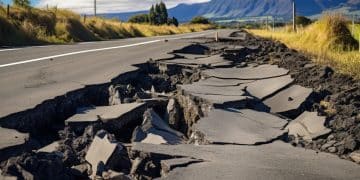Power Outages: Your Guide to Preparing and Surviving Blackouts in the US

Power outages can disrupt daily life in the US; preparation, including creating emergency kits, understanding alternative power sources, and staying informed, is essential for weathering extended blackouts safely and effectively.
Power outages: How to prepare for and survive extended blackouts in the US are crucial skills, especially given increasing climate-related disruptions. This guide will equip you with the knowledge to protect yourself and your family during these challenging times.
Understanding the Risks of Power Outages
Power outages can range from inconvenient to life-threatening. Understanding the various risks associated with these events is the first step in preparing for them.
Common Causes of Power Outages
Power outages can stem from a variety of sources, both natural and man-made. Knowing these causes can help you anticipate potential outages in your area.
- Severe weather conditions, such as hurricanes, tornadoes, and winter storms, are frequent culprits.
- Equipment failure due to age, overuse, or lack of maintenance can also lead to blackouts.
- Cyberattacks targeting the power grid pose an increasing threat to energy infrastructure.
- Planned outages for maintenance or upgrades are sometimes necessary but can still disrupt daily life.

Potential Dangers During a Blackout
Beyond the loss of convenience, power outages can present several serious dangers. Being aware of these risks allows you to take proactive measures.
- Loss of heating or cooling can be particularly dangerous for vulnerable populations like the elderly and infants.
- Food spoilage can occur quickly, leading to foodborne illnesses if precautions aren’t taken.
- Lack of lighting can increase the risk of falls and injuries, especially at night.
- Malfunctioning medical equipment that relies on electricity, like ventilators and oxygen concentrators, can become life-threatening.
Understanding these risks underscores the importance of developing a comprehensive preparedness plan. By anticipating potential dangers, you can mitigate their impact on your safety and well-being.
Creating an Emergency Preparedness Kit
An emergency preparedness kit is your lifeline during a power outage. Assembling a comprehensive kit ensures you have essential supplies readily available when the lights go out.
Essential Items for Your Kit
Every emergency kit should include basic necessities to help you weather the outage comfortably and safely. Here are some must-have items:
- Flashlights and extra batteries are essential for navigating in the dark. Consider LED flashlights for longer battery life.
- A battery-powered or hand-crank radio will keep you informed about weather updates and emergency broadcasts.
- A first-aid kit with bandages, antiseptic wipes, pain relievers, and any personal medications is crucial for treating minor injuries.
- Non-perishable food items, such as canned goods, energy bars, and dried fruits, provide sustenance without refrigeration.
Personalizing Your Kit
While a standard emergency kit covers basic needs, personalizing it to your specific circumstances is important. Consider the following:
- Include copies of important documents like identification, insurance policies, and medical records in a waterproof bag.
- Add items specific to your family’s needs, such as baby formula, diapers, pet food, and special dietary items.
- Store extra cash in small denominations, as electronic payment systems may not function during a power outage.
- Pack personal hygiene items like soap, toothpaste, and toilet paper to maintain cleanliness.
Regularly check and update your emergency kit to ensure items are in good condition and haven’t expired. A well-stocked and personalized kit can make a significant difference in your comfort and safety during a power outage.
Alternative Power Sources: Generators and More
Having access to an alternative power source can significantly ease the challenges of an extended power outage. Generators are a popular option, but other alternatives exist.
Understanding Generators
Generators provide a reliable source of electricity during blackouts. However, it’s crucial to understand their different types and how to use them safely.
- Portable generators are gasoline- or propane-powered and provide temporary power for essential appliances.
- Standby generators are permanently installed and automatically kick in when the power goes out.
- Always operate generators outdoors and away from windows and doors to prevent carbon monoxide poisoning.
- Install carbon monoxide detectors in your home to provide an early warning if the gas enters your living space.
Exploring Other Options
In addition to generators, several other alternative power sources can help you stay connected and comfortable during a power outage.
- Solar chargers can keep your mobile devices powered up, allowing you to stay in communication with others.
- Battery-powered inverters can convert DC power from car batteries to AC power for running small appliances.
- Consider investing in a portable power station, which can store energy for later use and power multiple devices.
- Explore renewable energy options like small wind turbines or solar panels for a sustainable backup power solution.

Choosing the right alternative power source depends on your budget, energy needs, and environmental concerns. Evaluate your options carefully to find the solution that best fits your circumstances.
Staying Safe During a Power Outage
Staying safe during a power outage requires vigilance and informed decision-making. Taking the right precautions can protect you and your loved ones from potential hazards.
Preventing Carbon Monoxide Poisoning
Carbon monoxide (CO) poisoning is a serious risk during power outages, often stemming from the improper use of generators and alternative heating sources.
- Never operate generators indoors, in garages, or near windows and doors.
- Ensure proper ventilation when using alternative heating sources like fireplaces or kerosene heaters.
- Install and regularly test CO detectors on every level of your home, especially near sleeping areas.
- Recognize the symptoms of CO poisoning, which include headache, dizziness, weakness, nausea, and confusion.
Food Safety and Preservation
Power outages can compromise food safety, leading to spoilage and potential foodborne illnesses. Follow these guidelines to minimize the risk:
- Keep refrigerator and freezer doors closed as much as possible to maintain a lower temperature.
- A full freezer can keep food safe for up to 48 hours; a half-full freezer for 24 hours.
- Discard any perishable foods that have been above 40°F (4°C) for more than two hours.
- Use a thermometer to check the internal temperature of food before consuming it.
By following these safety measures, you can minimize the risks associated with power outages and ensure the well-being of yourself and your family.
Staying Informed and Connected
Staying informed and connected during a power outage is crucial for receiving updates, seeking assistance, and maintaining contact with loved ones.
Utilizing Reliable Information Sources
Accessing reliable information is essential for making informed decisions during a power outage. Rely on official and trustworthy sources for updates:
- Monitor local news channels for updates on the outage, weather conditions, and emergency information.
- Check utility company websites or social media accounts for restoration updates and safety advisories.
- Tune into NOAA Weather Radio for up-to-date weather forecasts and alerts.
- Register for text alerts from your local emergency management agency to receive timely notifications.
Communication Strategies
Maintaining communication with family, friends, and emergency services is vital during a power outage. Plan ahead with these strategies:
- Fully charge mobile phones and power banks before an outage is expected.
- Keep a list of important phone numbers readily accessible.
- Designate a meeting place in case family members are separated.
- Consider purchasing a two-way radio for communication in areas with limited cell service.
Staying informed and connected ensures you have access to critical information and can communicate effectively with others during a power outage.
Community Support and Resources
During extended power outages, community support and available resources can be invaluable. Understanding how to access these networks can significantly aid your recovery.
Local Emergency Services
Local emergency services play a critical role in assisting communities during power outages. Familiarize yourself with the resources available in your area:
- Emergency shelters provide temporary housing, food, and medical assistance for those displaced by the outage.
- Local fire departments offer assistance with carbon monoxide detection and can provide guidance on safe generator use.
- Police departments can help with security concerns and direct you to available resources.
- Contact your local emergency management agency for information on community assistance programs and support.
Neighborly Assistance
Connecting with your neighbors can provide mutual support and assistance during a power outage. Reach out to those around you and offer help where you can:
- Check on elderly or disabled neighbors who may need assistance with food, medication, or transportation.
- Share resources like generators, extra batteries, or non-perishable food items.
- Create a neighborhood communication network to share information and updates.
- Work together to clear debris and ensure the safety of your community.
Accessing community support and offering assistance to others can foster resilience and help everyone navigate the challenges of a power outage more effectively.
| Key Point | Brief Description |
|---|---|
| 🔦 Emergency Kit | Assemble essential supplies like flashlights, food, first-aid, and medications. |
| ⚡️ Backup Power | Consider generators, solar chargers, or battery inverters for alternative power. |
| 🔥 Carbon Monoxide Safety | Never use generators indoors; install CO detectors, and ensure ventilation. |
| 📱Stay Informed | Use reliable sources for updates and plan communication strategies. |
Frequently Asked Questions (FAQ)
▼
Food typically stays safe for about 4 hours in a refrigerator if the door remains closed. Discard any perishable items like meat, poultry, fish, eggs, and leftovers that have been above 40°F (4°C) for more than two hours.
▼
If you suspect carbon monoxide poisoning, immediately move to fresh air and call 911 or your local emergency number. Seek medical attention as quickly as possible. Do not return to the building until it has been properly ventilated.
▼
A portable generator should always be operated outdoors in a well-ventilated area, away from windows, doors, and vents. Keep it dry and protected from rain and snow to prevent electrical hazards.
▼
Stay informed by monitoring local news channels, checking your utility company’s website or social media, tuning into NOAA Weather Radio, and signing up for text alerts from your local emergency management agency.
▼
To keep mobile devices charged, use power banks, solar chargers, or car chargers. Fully charge devices before an outage, and consider investing in a portable power station for a reliable backup power source.
Conclusion
Preparing for and knowing how to survive extended power outages: How to prepare for and survive extended blackouts in the US is a multifaceted endeavor that requires understanding risks, creating emergency kits, securing alternative power, practicing safety, staying informed, and leveraging community support. By taking proactive measures, you can protect yourself and your community from the challenges of prolonged blackouts.





